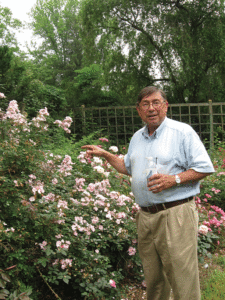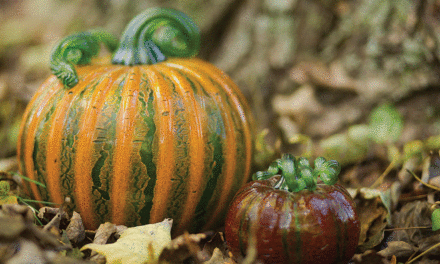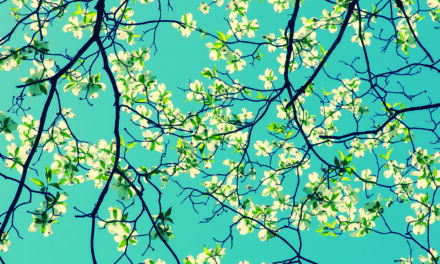
Nick Weber said his gardening interest came from his paternal grandmother. “My grandmother would come to our house to help my mother with our house chores almost weekly, and would often bring some plants from her garden to plant at our home,” he recalled. (Photo by Kathy Jentz)
Where to start when describing Nick Weber’s home garden in Brookeville, Md.?
His obsessive love of roses has grown from a hobby and blossomed into the renowned “Heritage Rosarium,” filled with nearly 700 heirloom varieties of ramblers and climbers.
Overwhelming and lovely at the same time, Nick’s collection is astounding and his generosity with his plant knowledge is amazing.
I have attended many of Nick’s garden club talks and always come away with pages of notes and lists of more plants that I want (need!) to acquire.
I asked Nick to talk about his love of roses and to share some rose growing advice with Eastern Shore gardeners. His answers follow below.
Q: What got you started in growing roses?
A: “I had an interest in gardening from the time of my childhood. It came from my paternal grandmother.
“My grandmother would come to our house to help my mother with our house chores almost weekly, and would often bring some plants from her garden to plant at our home.
“She would take a little time and ask me to help plant and talk about the flowers she brought.”
Q: Why roses? What is it about them that you find compelling?
A: “Roses gradually became a major gardening interest of mine not only for the diversity that I had begun to learn about, but roses in the various classes had interesting histories as alluded to in my notes above.
“I learned that there were a lot of books dealing with these Old Garden Roses (OGRs), which helped trace their history and a series of books published by Earl M. Coleman in the Old Rose Series in the 1970s became an inspiration for me to delve deeper.
“That is when I learned that there was a whole group of Rosarians who loved OGRs.
“One of those books, “Old Roses” by Ethelyn Emery Keays, became a great interest to me because she had lived in nearby Calvert County at “Creek Side” on St. Leonard’s Creek near the town of Lusby and gardened there from 1928 to the late 1940s.
“As found in Leonie Bell’s New Forward to “Old Roses,” Mrs. Keays published 13 articles in the American Rose Annuals with the first in 1932 entitled “Old Roses in Calvert County, Maryland.”
“By the late ‘70s and early ‘80s I had entered the world of OGRs and hunted them with Leonie Bell at Creek Side. There was a whole cast of characters nationwide involved with Old Roses.
“One of the most historic roses that I quickly sought was Old Blush, a china rose dating to 1752 when it was brought to Europe, and is widely understood to have been in existence much longer. Old Blush is called one of the four stud chinas because it is found in the heritage of a huge number of roses that succeeded it. Its repeat bloom was one of its compelling traits. Early on, I came across Marie Pavie, a polyantha rose, that can grow well with as little as three hours of sun, blooms from May until a hard freeze, is fragrant and reasonably-disease resistant. I still grow them both today.”
Q: What roses do you think are over-used these days?
“A: Knock Out roses and small, shiny-leaved shrub roses are over-used in landscape plans today. They are used because of their disease-resistance and repeat bloom.
With these characteristics, color can be a part of the landscape for the whole season without any significant care other than mulch to ward off weeds along with occasional watering.”
Q: Which roses do you wish people grew more of?
A: “I wish that people would grow more roses in general depending on their landscape needs. There are whole classes of roses that can fill those needs from climbing roses to the wonderfully fragrant tea roses like Mrs. B R Cant (these are not hybrid tea roses). Large shrub roses like the Hybrid Musks or smaller shrub roses like the Polyantha Roses. These are but a few of the classes of roses that will fill wonderful places in flower borders with color and in many cases fragrance. A new class of roses called English Roses championed by David Austin combines the bloom characteristics of the OGRs along with many of their special fragrances.”
Q: For those on the Eastern Shore, what roses do you recommend and why?
A: For the Eastern Shore virtually all roses can be grown because of the more favorable temperature roses are likely to find there. Pure tea roses should be grown there in general, because of their fragrance and general disease-resistance. The china roses will do well there also. I would also enjoy some modern English Roses by Davis Austin with an eye for disease-resistance in their descriptions.
“For those who want to explore a bit on the computer look for “Earth Kind” roses. These are roses that can withstand less care than a rosarian might be expected to give and after the roses get situated.
“They are reasonably disease resistant like Knock Out but can provide other bloom and plant characteristics. These roses come from several classes. There are more than 100 roses that are as disease-resistant as Knock Out. Also consider Marie Pavie mentioned above. I wouldn’t be without it.”
Q: Do you have any rose growing tips, tricks, or trouble-shooting solutions?
A: “Plant your rose well. An ample hole of 20 inches by 20 inches that has been tested to drain well when a couple of gallons of water has been poured into it within an hour. Mix the removed soil (1 part) with 1 part leafgro or compost plus 1 part promix. Add and mix with the soil mix with 1-2 cups of bone meal up to 2 cups of dolomite lime, if you have acidic soil, 3 cups of green sand and 4 cups of humates, if available. If you have a bare root rose that has been soaked 24 to 48 hrs, add some of the above mixture to the hole and make a cone to position the rose stem over the cone mound with the roots trailing down while spreading out. Sprinkle ½ cup of triple superphosphate (0-45-0) on the cone.
“Make sure that the rose bud union (swollen part from where the canes emerge) will be a couple of inches below the surrounding bed level. On the Eastern Shore, the bud union can be closer to bed level because of the warmer winter temperatures. Add some of the mix into the hole with placed rose to about the ¾ full level and add water to wet the soil well to remove the air holes. Then fill the hole to ground level and water again.
“Finally, mound the excess soil mix to make a mound covering the canes 4 to 6 inches high to protect them while the plant begins to grow. When new growth has begun carefully remove the excess soil with a light stream of water.
“After growth has begun, feed with a cup of an organic plant food (ex. Plant Tone) sprinkled lightly around the base and scratched in on April 15, June 15, and August 15 to aid the plant growth. Two inches of double shredded hardwood mulch is beneficial throughout the year.
“Fourth: Make sure that the roses get ample water throughout the first year in particular — at least an inch per week over the planting area. Consult with the Rosarian for disease issues, if they arise.”
Q: Are there any roses that originated locally or that have a local history tie-in (specifically any on Eastern Shore/Annapolis?)
A: Roses that have a local history can be found in the writings of Mrs. Keays mentioned above. A hybrid tea rose that has a history from the local area is Radiance, the most famous of more than 25 roses bred by John Cook of Baltimore and introduced in 1908.
“It was the most widely distributed hybrid tea in America for many years and is available even now. There are four known sports of Radiance including Red Radiance introduced in 1916 by Gude Brothers of Rockville, Md. Other Cook introductions included Francis Scott Key, Glorified La France, My Maryland, and Souvenir of Wootton.
“There are also a couple of local hybridizers who have introduced hybrid tea roses that compete at the national level – John Smith (HT- Randy Scott) Silver Run, Maryland and Ernie Earman (HT – Let Freedom Ring) from Arlington, Virginia recently deceased.”
Q: When you are not growing roses, how do you spend your time?
A: “I also grow dahlias and am president of the National Capital Dahlia Society. Other interests include fly fishing for trout and other fish.
“Finally, enjoying four grandsons and trying to teach them some of the excitement of my hobbies along with the aforementioned activities fill my days.”
(Editor’s note: Kathy Jentz is the Editor/Publisher of Washington Gardener Magazine. A life-long gardener, Kathy believes that growing plants should be stress-free and enjoyable. Her philosophy is inspiration over perspiration. She can be reached at athyJentz@gmail.com or 301-588-6894.)





